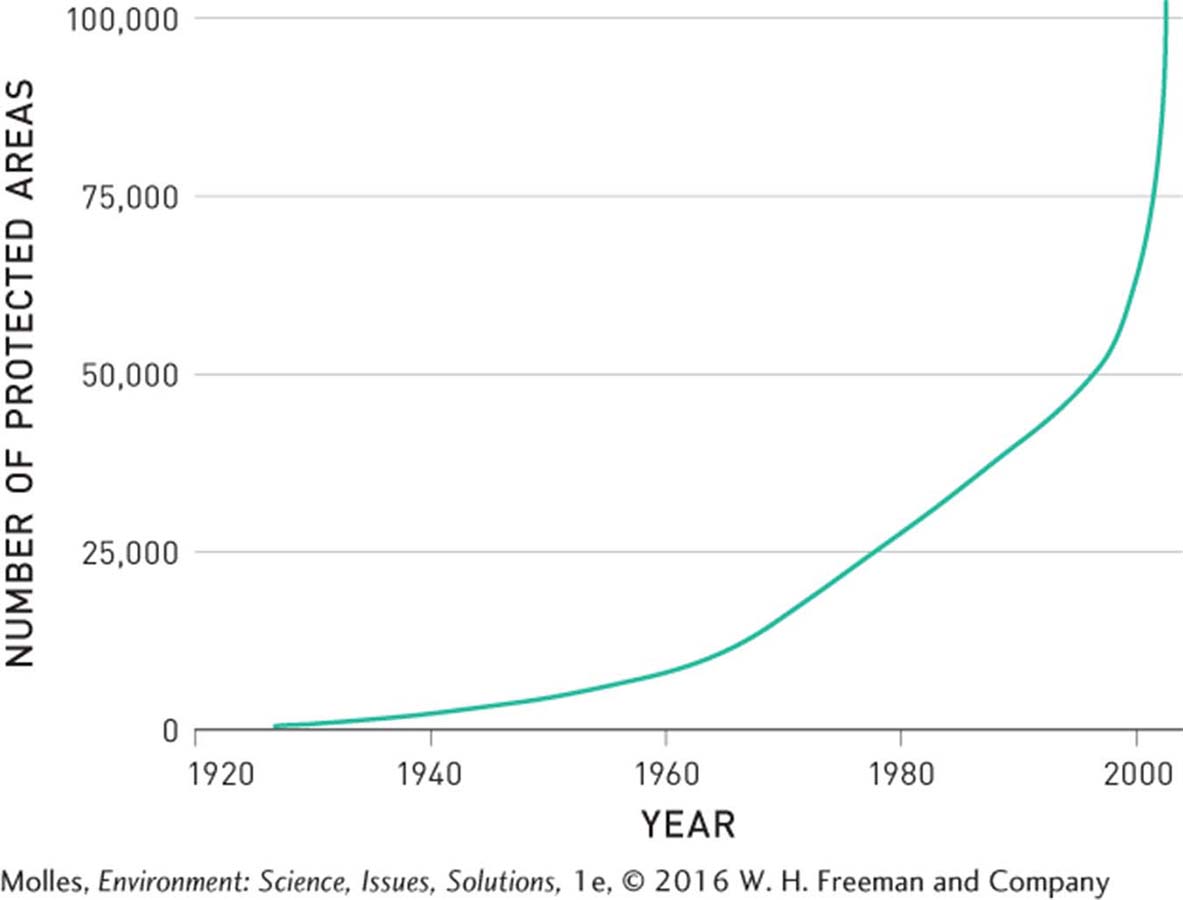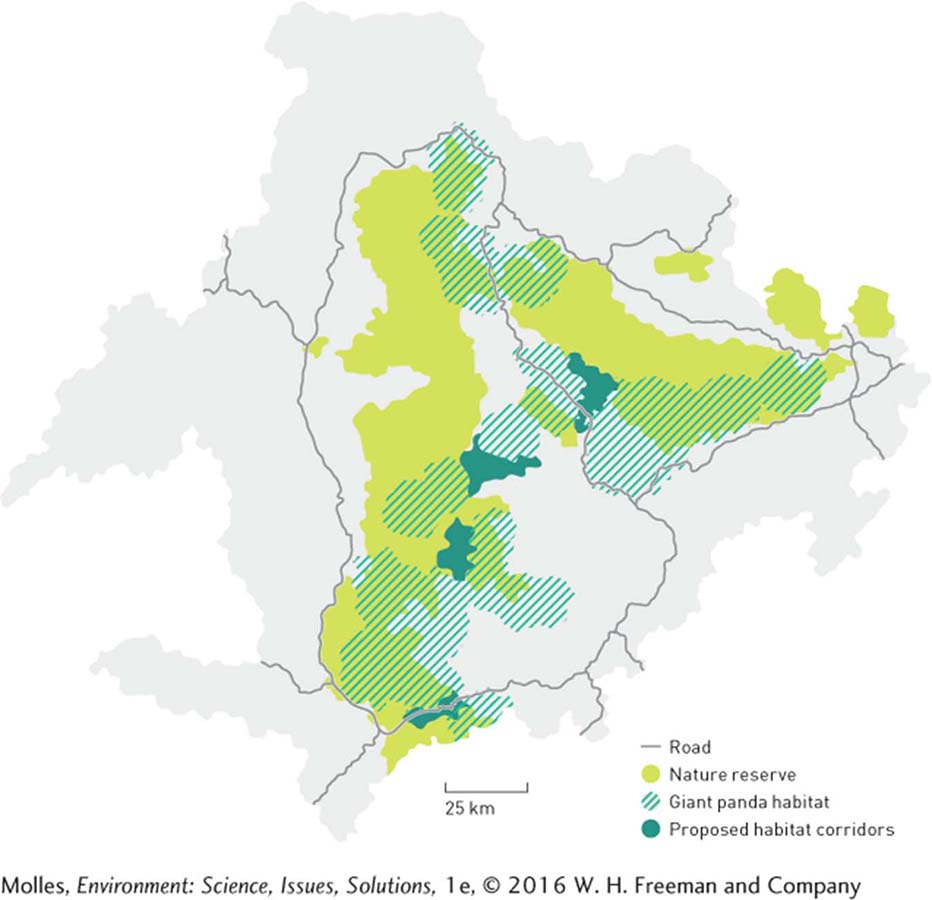4.9–4.12 Solutions
The two major focal points for biodiversity conservation and restoration are on species (emphasized in Chapter 3) or on ecosystems. Often, these approaches are presented as polar opposites. However, it is apparent that conserving endangered species requires healthy, functioning ecosystems. Wild species do not live apart from the ecosystems on which they depend. Similarly, wherever we conserve or restore natural ecosystems, we sustain many species populations. Some of the most extensive programs to protect whole ecosystems have involved setting aside protected areas.
Convention on Biological Diversity An international agreement negotiated under the sponsorship of the United Nations Environmental Programme to promote the conservation of biological diversity, the sustainable use of its components, and the fair and equitable sharing of the benefits arising out of the utilization of genetic resources.
Concern that the world’s ecosystems were under threat led 168 countries of the world to sign the Convention on Biological Diversity following the “Earth Summit” meeting in Rio de Janeiro, Brazil, in 1992. It was a defining moment in the history of the relationship between humans and the biosphere, as it came with the recognition that protecting ecosystems is fundamental to economic development. Even the site of the meeting was significant—
The Convention has charted a clear path toward finding a solution to the biodiversity crisis, requiring countries to meet a variety of milestones, including setting aside 26% of their land area and 17% of their territorial seas as protected areas. In addition, the nations need to ensure the effectiveness of their national parks and other protected areas by developing management plans for them and identifying the impacts of climate change. As of 2015, 196 nations had ratified or accepted the Rio Convention (although U.S. president Bill Clinton signed the Rio Convention, the Senate has not ratified it). To date, most countries have failed to meet their goals, but there have been significant conservation successes over the last 20 years.
4.9 The number of protected areas has grown rapidly
protected area A geographically defined area designated or regulated and managed to achieve particular conservation objectives (e.g., national parks, national forests, wildlife refuges).
One of the principal means of conserving an ecosystem is to protect it. The Convention on Biological Diversity defines a protected area as a geographically defined area that is designated or regulated and managed to achieve particular conservation objectives. The various types of protected areas range from strict nature reserves, set aside mainly for scientific research and in which tourism is prohibited, to areas protecting biodiversity but managed for sustainable harvest of natural resources such as timber and game animals. Generally, local laws regulate the use of protected areas.
The world’s oldest protected areas were sacred sites valued as the homes of the gods or as resting places for the dead. Protection of the resources produced by an ecosystem came later. In Japan, for instance, forests providing timber for the construction of Shinto temples have been protected for over 2,000 years. Hunting preserves were established in northern India around the same time. The first large natural area protected for purely aesthetic reasons was Yellowstone National Park.
The founding of Yellowstone inspired the establishment of national parks and other types of protected areas the world over. Between 1872, the date of Yellowstone’s founding, and 1962, the number of protected areas grew to over 10,000. Today, there are more than 100,000 protected areas across the globe, encompassing nearly 19 million km2, more than the combined areas of the United States and Brazil. In total, about 12% of Earth’s land surface is afforded some degree of conservation protection (Figure 4.25).

Size and Connections in Protected Area Design
habitat corridor A strip of suitable habitat linking protected areas intended to increase the movement of wildlife between protected areas to sustain genetic variation and reduce the likelihood of extinction of protected populations.
When it comes to nature reserves, bigger is better. Unfortunately, that’s not always practical. One key to sustaining functioning ecosystems in smaller reserves is to ensure that they have connections, or habitat corridors, to other reserves. Habitat corridors increase the movement of organisms among protected areas; increase gene exchange between separated populations, which helps maintain genetic diversity in local populations; and reduce the chance of extinctions in habitat fragments. In southern China, for instance, environmental scientists have identified potential habitat corridors between existing reserves for the giant panda in the Minshan Mountains (Figure 4.26). If adopted by the government, this conservation plan would reduce habitat fragmentation and multiply the size of the panda protected area, making the future of the species more secure.

Marine Protected Areas
marine protected areas (MPAs) Protected areas in coastal regions and the oceans that help conserve ecosystems critical for biodiversity (e.g., coral reefs and salt marshes) and sustain populations that supply fish and other marine resources.
Protected areas in coastal areas and the oceans, called marine protected areas, or MPAs, help conserve ecosystems critical for biodiversity, such as coral reefs and salt marshes, and sustain populations that supply us with fish and other marine resources. For many years, protecting marine habitats was ignored, compared with protecting terrestrial habitats, but that’s slowly changing. In 2006 President George W. Bush declared 36 million hectares of marine habitat in the Pacific Ocean the Papahanaumokuakea Marine National Monument, which became one of the largest MPAs in history. Studies have shown that properly managed MPAs provide a refuge for fish to breed and replenish exploited fisheries. In fact, social scientists have found links between MPAs and a reduction in poverty among small fishing communities in places such as Papua New Guinea and Indonesia—
Think About It
The United Nations Environmental Programme notes in a recent report that most of the world’s largest protected areas are in remote, low-
diversity regions, including ice caps and deserts. What does this bias reveal about the actual commitment to biodiversity protection? What political, economic, and social conditions could lead to the creation of large protected areas in high-
diversity areas where human population densities are high?